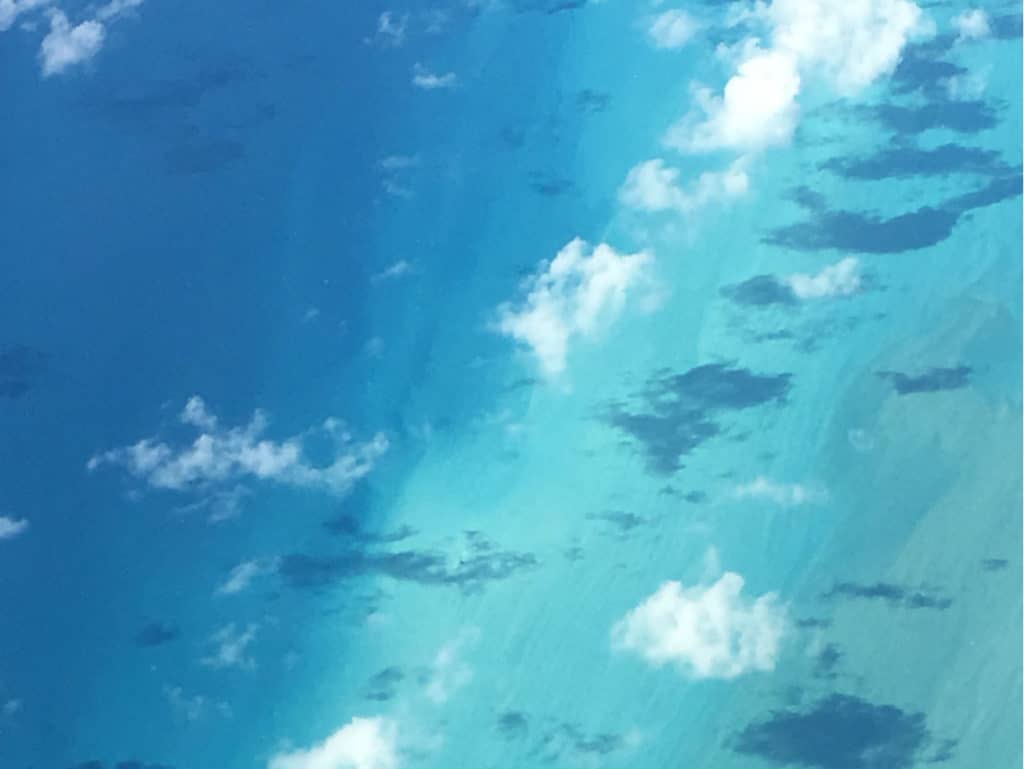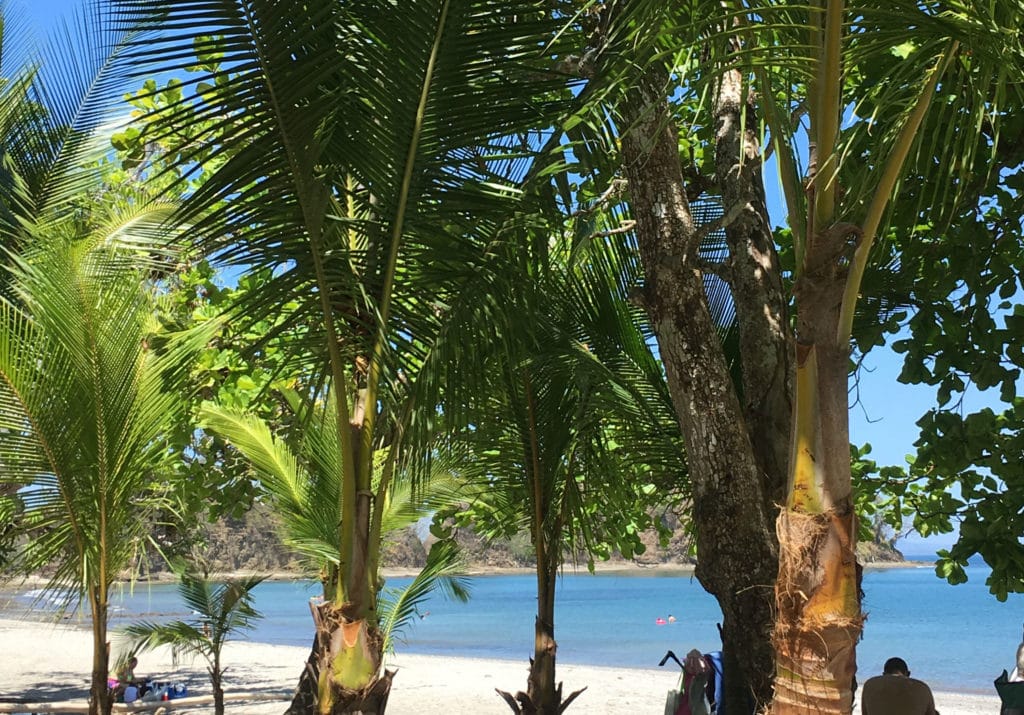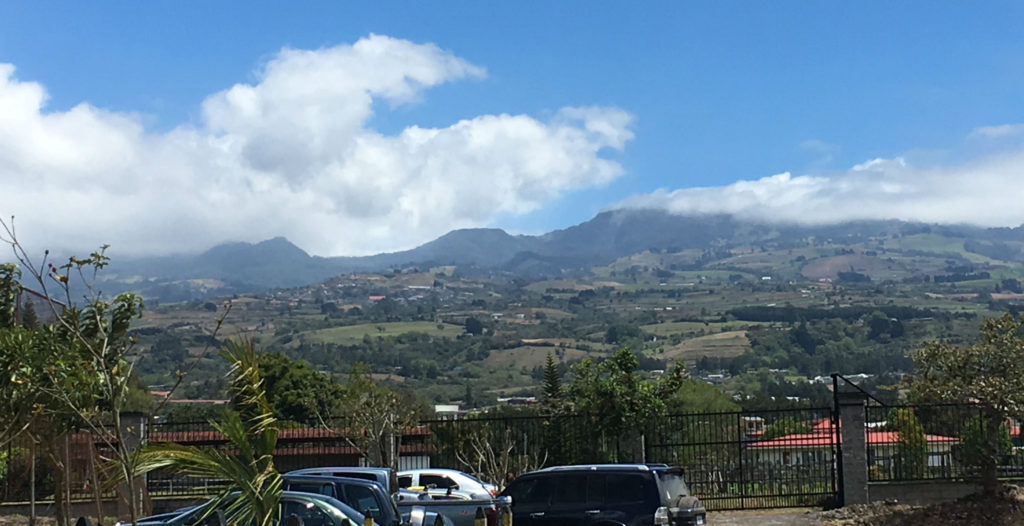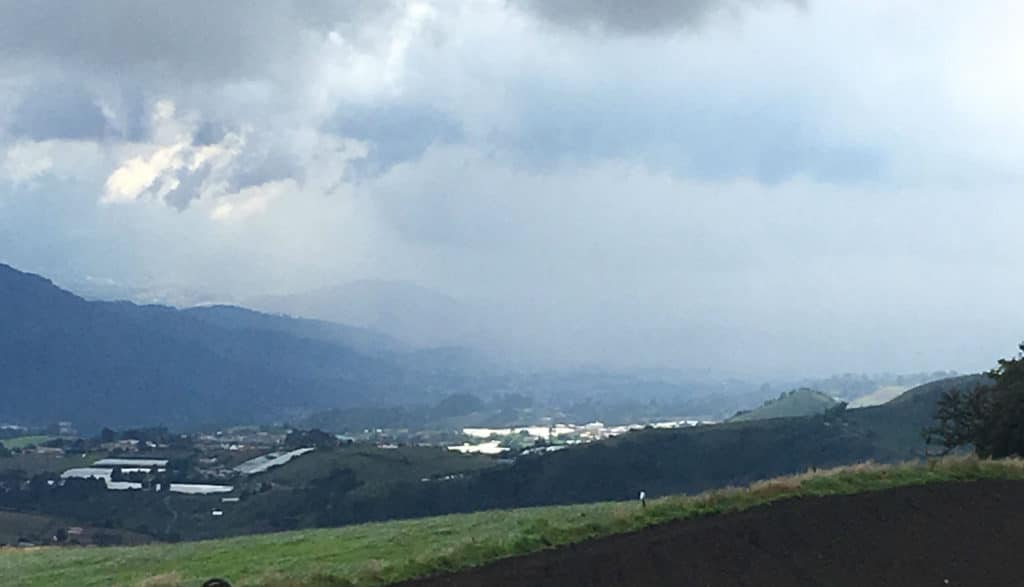As I was perusing my list of blog post topics, I realized that a lot of my posts already assume that the reader knows quite a bit about Costa Rica. Today, more than ever, you can find tons of information on Costa Rica online, right at your fingertips.
There are tons of good websites, travel books, blogs, and travel magazines absolutely love publishing snippets on Costa Rica.
But, let’s assume you’re new to Costa Rica. Let’s take a few steps backward and discuss Costa Rica for absolute beginners.
Costa Rica 101
Costa Rica is a small country located in Central America. It sits between Nicaragua (to the north) and Panama is its southern border.
On Costa Rica’s east is the Caribbean Sea and to the west is the Pacific Ocean.
Costa Rica is about a three-hour flight from Atlanta, or two and a half hours from Florida. It’s southwest of Florida and when you fly to Costa Rica, you’ll fly over Cuba. You’ll also have a front-row seat to view the Caribbean, as shown below. Beautiful, isn’t it?!

A lot of people confuse Costa Rica with Puerto Rico and are even more befuddled when I tell them it’s possible to drive to Costa Rica. And, it is. I’m not sure if it’s the safest venture, but it is possible.
Costa Rica’s capital is San José, and people again confuse it with Puerto Rico’s capital, San Juan.
Costa Rica is a small country, roughly about the size of West Virginia. However, for a country so small, Costa Rica has almost every single landscape you could imagine.
Costa Rica is divided up into seven provinces. Much like counties or townships in the states. These provinces are San José, Cartago, Alajuela, Heredia, Limón, Guanacaste and Puntarenas. Each province has unique and special qualities specific to that area.
More Costa Rica Basics
The population of Costa Rica is just under 5 million people. That’s a lot of people. Of course, when you figure that there are 8.5 million living in New York City alone, I think Costa Rica’s population is definitely more reasonable!
The main language of Costa Rica is Spanish. However, many, many people speak English as well. If you don’t speak Spanish, you will definitely be able to get by, but please try to learn some Spanish before you go. It’s one of the nicest ways to respect your Costa Rican hosts.
The predominant religion is Roman Catholic, but there are also protestant churches as well as synagogues.
The monetary unit is the colon. Right now, $1.00 U.S. Dollar = roughly 536 colones. That number constantly changes. A lot of people shave it down to 500 colones = $1.00. That’s off, but it makes life easier when you think of 10,000 colones as $20.00. 5,000 colones as $10.00, and so on.
The school system is similar to the states in that there is a primary school, a secondary and college, or university. There are also many private schools and many bilingual schools. Most kids wear uniforms to school. When I was an exchange student we wore uniforms and I loved it! You never had to figure out what to wear each day and everybody was on equal ground. The school year begins around February and ends around late November. Students (and a lot of workers, too) get a two-week vacation in July.
Costa Rica’s main agricultural exports include coffee, sugar, bananas and pineapples.
The Costa Rican Landscape
Being a small country, you can drive from one coast to the other in a relatively short period of time. If conditions cooperate. Don’t let Costa Rica’s small size fool you. It sometimes can take hours to go small distances because of twisty mountain roads, landslides during the rainy season, traffic (which has exploded in recent years), and any other unexpected events.
Running down the center of Costa Rica is a mountain range called the Cordillera Central, or Central Mountain Range. This is where you’ll find Costa Rica’s bigger cities such as San José, the capital; Alajuela (which is actually the city that Juan Santamaría Airport is closest to) and Cartago, my base of operations.
The temperatures can vary. Alajuela is usually very sunny and warm. This area is home to many, many ex-pats due to its almost perfect weather year-round. Heading south to San José, the temperature is also very agreeable. Further south to Cartago, temps usually run about 70 degrees but can go as low as the 50s in the evenings. Cartago is also famous for her rainy, cold drizzle, and misty nights.
Cartago’s temperatures are why I usually chuckle when somebody thinks I’ll be laying by the sea sipping margaritas while I’m in Cartago.
Near the central part of Costa Rica is where you’re able to see cloud forests as well.
Costa Rica’s Two Coasts
Head either east or west towards the ocean and that’s when you’re going to start feeling some heat. However, the coasts are different.
If you’ve decided on venturing to the Caribbean coast, be prepared for classic, tropical weather. The heat on this coast is very moist and humid. The vegetation is tropical and towns take on a very Caribbean feel. You’ll pass banana plantations and palm oil “forests”. The area is stunningly beautiful.
The Caribbean coast has a very straight coastline causing the surf to crash harshly against the shore. Swimming can be dangerous during certain times. Surf competitions are held in this area of the country.
The Pacific coast, on the other hand, has a jagged, roughly etched-out coastline, creating a gentler tide and more swim-friendly beaches. The heat on the Pacific coast is much drier than the Caribbean, but intense nonetheless.
Sunscreen should be mandatory on either coast!

The scenery of the Pacific side is less tropical and dense than the east coast, and beaches vary from one to the next. Some are even made up of black volcanic sand (Playa Ocotál) and others are made up of tiny pieces of shell (Playa Conchál).
Costa Rican Volcanoes
Costa Rica is home to many volcanoes, the most famous being Arenal, Irazú, Poás, Turrialba, Rincón de la Vieja, Tenorio and Barva. There are also more inactive volcanoes.
If you have never been to a volcano, I highly recommend it. There’s nothing like bragging to your pals back home that you stood atop a volcano and looked inside.
The Irazú Volcano, right in Cartago, is a splendid, unforgettable journey. Poás and Arenal are fantastic as well. All three are active. Poás gets worked up quite often and spews steam and rocks, so make sure the park is open before you head out.
At Irazú, you can drive or take a bus to the park. Then, hike around the volcano and peer down below into its craters.

Poás also has a park, and the crater is truly breathtaking, as is its nearby lake.
The Turrialba Volcano (in the Cartago province) has also been rumbling and spewing ash during the past couple of years, even closing the airport for brief periods.
Arenal is your typical conical-shaped volcano, and at certain times you can see lava after dark. It’s a sight to see.
Speaking of rumbling, earthquakes happen very frequently in Costa Rica. Some say almost every day, but most of this seismic activity can’t be felt.
What Can I Do in Costa Rica?
A shorter list would be, “what can’t I do in Costa Rica?”
Here’s a brief rundown: you can zipline. But you already knew that, right?
You can visit a volcano. How about visiting the rainforest? You bet. Try the Aerial Tram. You can visit dozens and dozens of beaches. Some tropical. Some volcanic. You can surf. There’s river rafting, camping and rappelling. Into bungee jumping and skydiving? Costa Rica offers that as well.
I’ll pass on the skydiving.
Did you say world-class fishing? Yes.
Coffee lover? Costa Rica is home to what I consider the best coffee in the world. Take the Britt coffee tour and learn how coffee is harvested and processed. Or, just spend your day going from cafe to cafe.
Like shopping? Costa Rica has awesome malls and shopping centers and of course, my favorite, the marketplaces.
Love those cuddly and cute sloths? Costa Rica has a sloth sanctuary so you can get to know those adorable little guys.
Love museums? You’ve come to the right place.
Bird watching? PLEASE come to Costa Rica.
Craft beer? You’ll find it in Costa Rica.
Like churches? Costa Rica is home to the famed Basilica de Los Angeles and hundreds of other churches to explore.
But wait…you say want to stay on an all-inclusive resort and just relax (and realize that dream of sipping a piña colada as the world goes by?) Yes. Costa Rica has that, too. But I URGE you. Get off the resort and explore the country. That’s where the real beauty is.
Costa Rica’s biodiversity provides unending activities. Since you’ve got beaches on both sides, mountains, cloud forests and rain forests in the center, it’s a paradise for nature lovers and culture lovers alike.
A word of advice: don’t try to do all this stuff on one trip. Concentrate on a few things you love and save the rest for the next trip. Driving time can take longer than you expect.
Is Costa Rica Safe?
I get this question a lot. Is Costa Rica safe? Should I travel there?
Yes, Costa Rica is very safe. Whether you opt to travel there yourself or as part of a group tour, the country is very safe. I understand it’s intimidating and worrisome to travel somewhere new for the first time. You don’t know the lay of the land and you might feel off your guard.
That said, be smart. This applies to anywhere in the world you might travel. Just don’t do stupid stuff. Don’t go walking around an unfamiliar place at 2:00 am. Don’t flash money at the ATM. Don’t flaunt fancy and expensive jewelry. Don’t make a spectacle of yourself. Don’t be rude or belligerent. Don’t engage in illegal activities. If you feel like something is off, trust your instinct. It’s really that simple, folks.
Before you go, read. Educate yourself.
Costa Rica thrives on its tourism. That coupled with Costa Ricans being some the happiest and friendliest people in the world, makes it a perfect place to visit again and again.
Pura Vida!






Sounds so beautiful. I never knew. A hidden Gem. Hopefully it won’t be inundated with too much tourism.
Costa Rica thrives on tourism. It’s a booming industry. Since there’s endless types activities, the tourists tend to get spread all over the country. You’re likely to see more travelers in cities like San Jose, and many of the beaches, especially Jaco. The smaller, more rural areas tend to be untouched.
Great write-up for newcomers to Costa Rica!
Hi Joseph, thanks for the shout-out! Just checked out your site, too, looks like you’re living the dream! Best of luck to you, I’m in the process of getting rid of my snow shovel, too. Cheers!